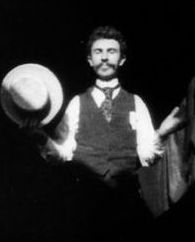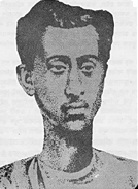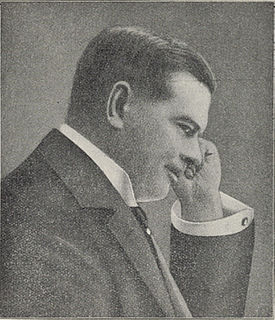
William Kennedy-Laurie Dickson was a Scottish inventor who devised an early motion picture camera under the employment of Thomas Edison.
Thomas J. Armat was an American mechanic and inventor, a pioneer of cinema best known through the co-invention of the Edison Vitascope.

Kinemacolor was the first successful colour motion picture process, used commercially from 1908 to 1914. It was invented by George Albert Smith of Brighton, England in 1906. He was influenced by the work of William Norman Lascelles Davidson and, more directly, Edward Raymond Turner. It was launched by Charles Urban's Urban Trading Co. of London in 1908. From 1909 on, the process was known as Kinemacolor. It was a two-colour additive colour process, photographing and projecting a black-and-white film behind alternating red and green filters.

George Albert Smith was an English stage hypnotist, psychic, magic lantern lecturer, Fellow of the Royal Astronomical Society, inventor and a key member of the loose association of early film pioneers dubbed the Brighton School by French film historian Georges Sadoul. He is best known for his controversial work with Edmund Gurney at the Society for Psychical Research, his short films from 1897 to 1903, which pioneered film editing and close-ups, and his development of the first successful colour film process, Kinemacolor.
The actuality film is a non-fiction film genre that, like the documentary film, uses footage of real events, places, and things, yet unlike the documentary is not structured into a larger argument, picture of the phenomenon or coherent whole. In practice, actuality films preceded the emergence of the documentary. During the era of early cinema, actualities—usually lasting no more than a minute or two and usually assembled together into a program by an exhibitor—were just as popular and prominent as their fictional counterparts. The line between "fact" and "fiction" was not so sharply drawn in early cinema as it would become after the documentary came to serve as the predominant non-fiction filmmaking form. An actuality film is not like a newspaper article so much as it is like the still photograph that is published along with the article, with the major difference being that it moves. Apart from the traveling actuality genre, actuality is one film genre that remains strongly related to still photography.
The Charles Urban Trading Company specialised in travel, educational and scientific films. It was formed in 1903 in London by the Anglo-American film producer Charles Urban, who struck out on his own after five years at the Warwick Trading Company. The slogan of the Charles Urban Trading Company was 'We Put the World Before You'.

Hiralal Sen is generally considered as one of India's first filmmakers. A noted photographer, he is also credited with creating India's first advertising films and quite possibly India's first political film. A fire in 1917 destroyed all of his films.
The decade of the 1890s in film involved some significant events.
The Royal Bioscope Company was the first film production company in Bengal, and possibly the first in India, set up in 1898 by Hiralal Sen, along with Matilal Sen, Deboki Lal Sen, and Bholanath Gupta. The initial productions used an Urban Bioscope bought from Warwick Trading Company in London. The company produced shows, generally exhibited at the Classic Theatre in Calcutta, where the films featured in the intervals in the stage shows. When Sen began producing his own films regularly they were chiefly scenes from stage productions at the Classic, between 1901 and 1904. The longest film produced was Ali Baba and the Forty Thieves (1903), again based on an original Classic Theatre staging.

William Haggar was a British pioneer of the cinema industry. Beginning his career as a travelling entertainer, Haggar, whose large family formed his theatre company, later bought a Bioscope show and earned his money in the fairgrounds of south Wales. In 1902 he began making his own short fictional films, making him one of the earliest directors in Britain. His films were shown worldwide and his short Desperate Poaching Affray is believed to have influenced early narrative drama in American film, especially in chase genre. As a director Haggar is recognised for his use of editing and the depth of staging in his melodramas and crime films.
Sir Walter Gibbons (1871–1933) was the owner of a number of music halls in Britain at the beginning of the twentieth century. Along with Oswald Stoll, he led the employers' side in the Music Hall Strike of 1907, which was won by the artists, musicians and stage hands who were demanding better wages and conditions.

The National Society of Operative Printers and Assistants (NATSOPA) was a British trade union.

Kattukkaran Varunny Joseph who is known as "Father of malayalam Cinema Theater Industry" was an industrialist who established the former film exhibiting company in Kerala named Royal Exhibitors. He started Jose Theatre in Thrissur which is the first permanent theatre in Kerala and Davison Theatre in Kozhikode under Royal Exhibitors. He had been established the first electrically operated film projector Jose Electrical Bioscope at Ollur, Thrissur city in 1913.
Francis Duncan Smith (1873–1961) was a British naturalist and nature documentary pioneer who worked for producer Charles Urban. He specialised in micro-cinematography and pioneered many of the techniques of future natural history filmmaking.
Britain Prepared (1915) is a British documentary feature film. The film is silent and made in black-and-white with some colour sequences in the Kinemacolor additive color process.

Randall Kay Williams was a Victorian showman noted for popularising moving pictures on British fairgrounds. The first known reference to Williams exhibiting films in his show was at Rotherham Statute Fair on 2 November 1896.










